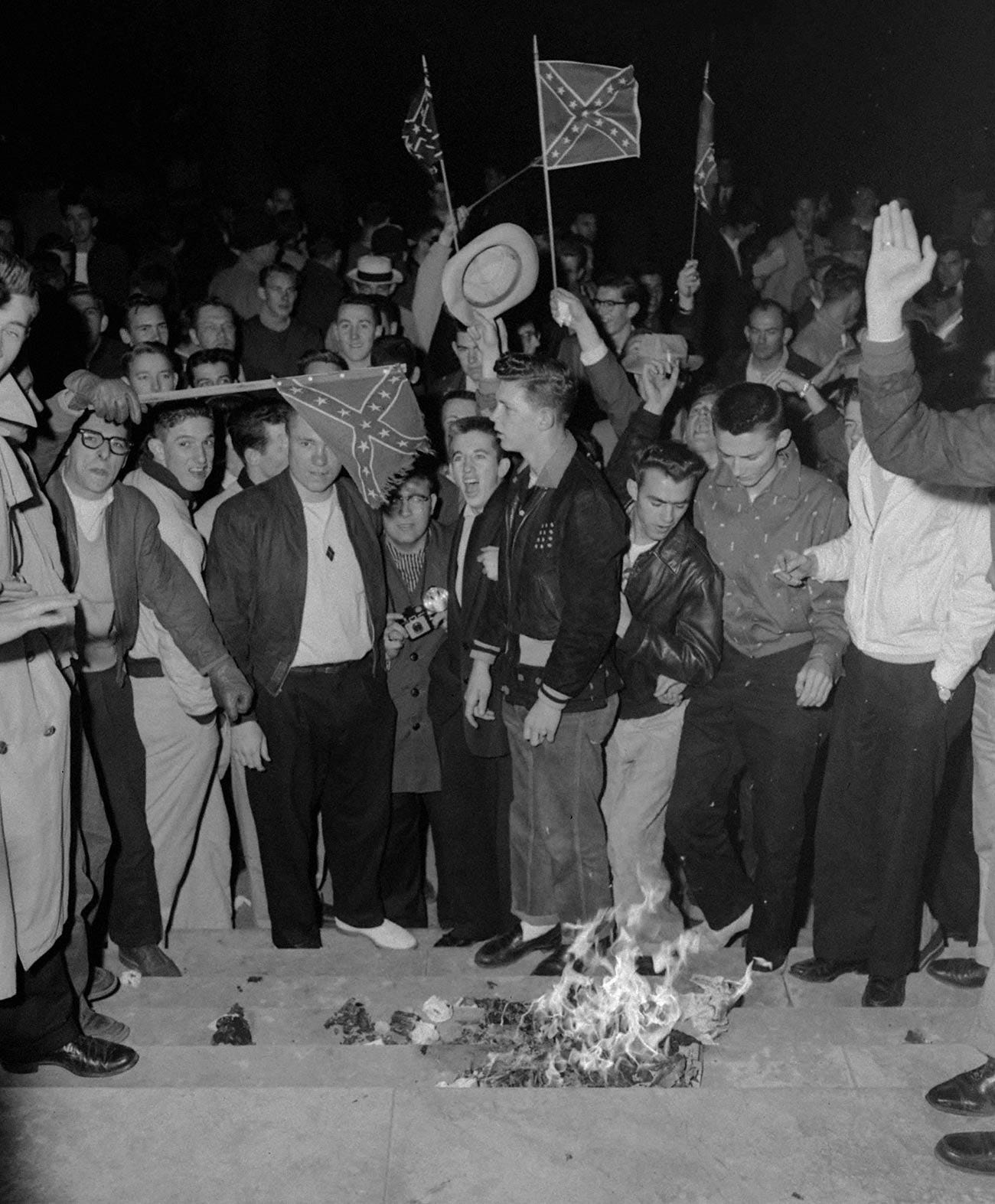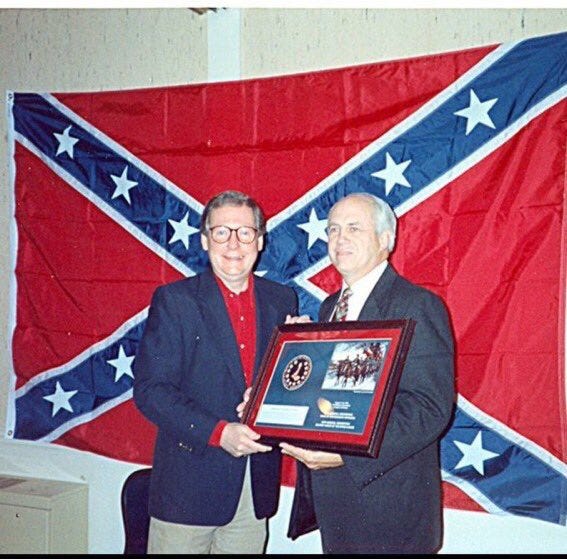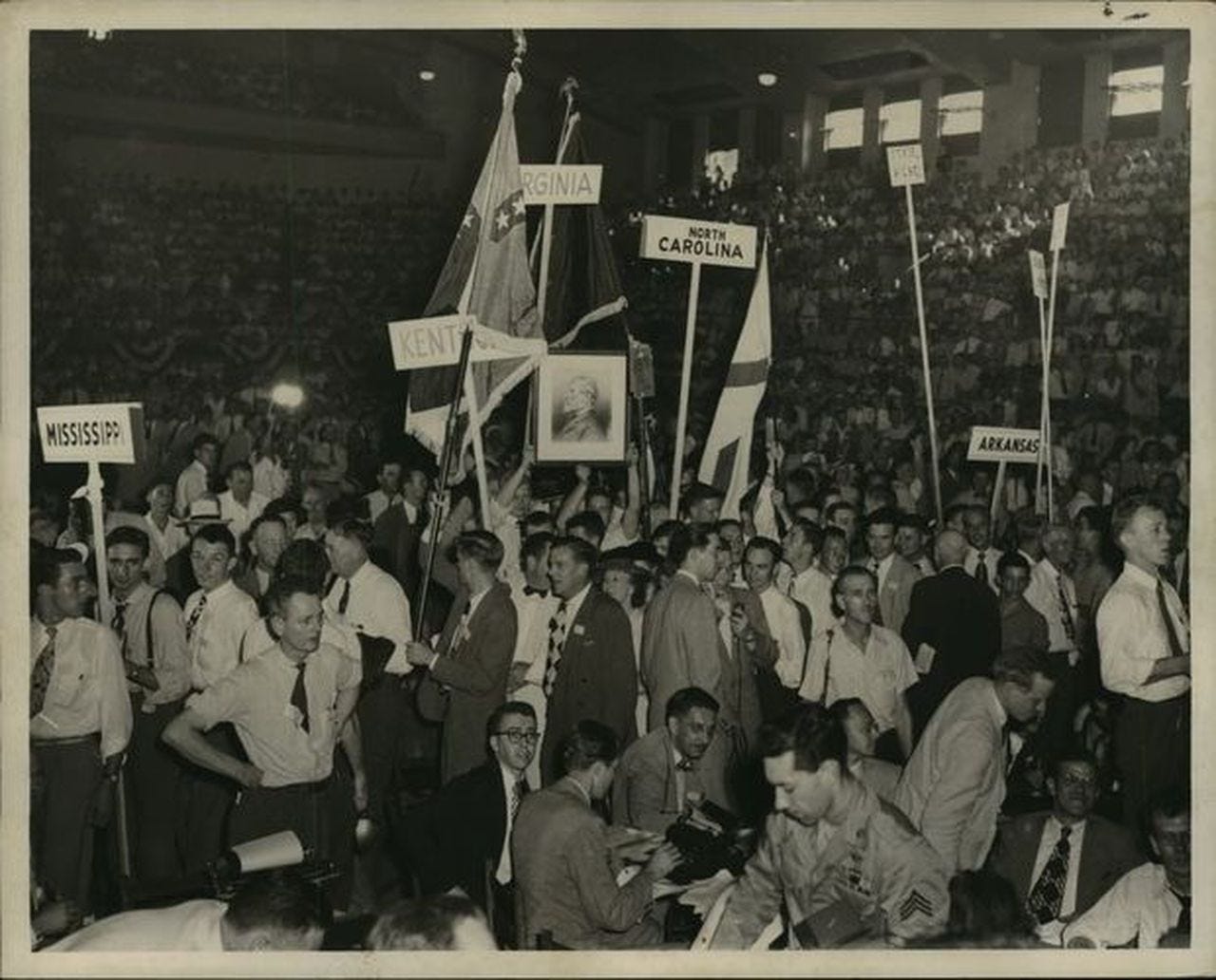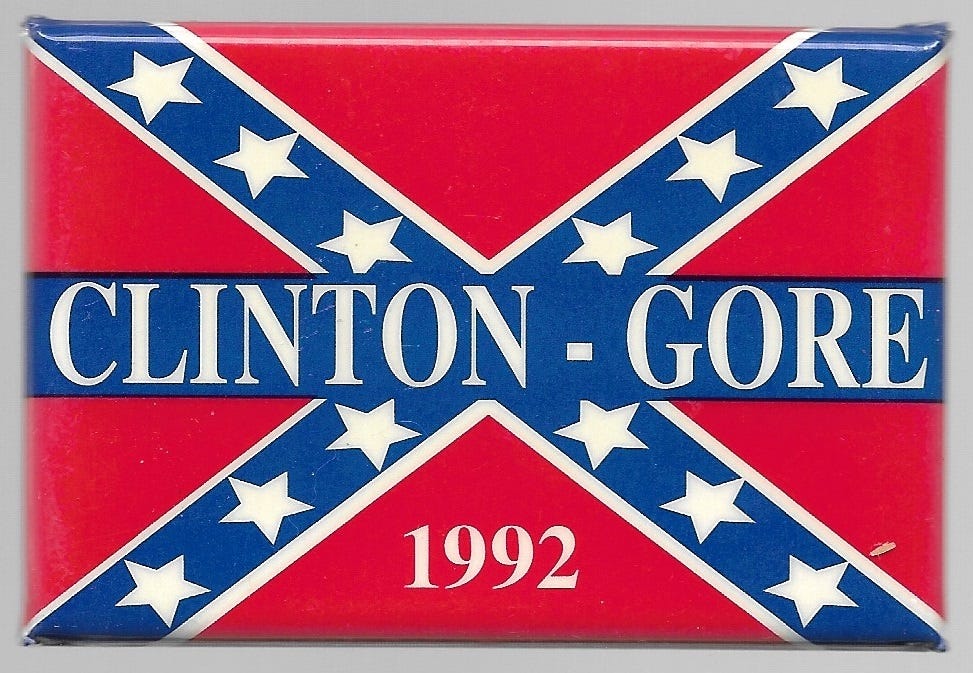No one was surprised when Senate Minority Leader, Republican Mitch McConnell, announced that he would not vote in favor of confirming Judge Ketanji Brown Jackson to the Supreme Court. In response, a photograph dating to the 1990s of McConnell accepting a plaque from a member of the Sons of Confederate Veterans in front of a large flag resurfaced on social media.
To be more accurate, it has appeared routinely on twitter and other social media platforms over the past few years.
For many people the photograph lends support to the racist motivations behind McConnell’s vote. The photograph also brings into stark relief Judge Brown’s own experience with the Confederate flag while at Harvard. It is also a reminder that in 2022 only one of the two political parties openly embraces Confederate iconography.
Former President Donald Trump repeatedly defended Confederate monuments and the men they honor during his presidency. Republicans at the state level have passed legislation that continue to prevent communities from deciding whether to keep or remove Confederate monuments.
Over the past few years, Republicans have openly campaigned in support of the flag and Confederate leaders.
It wasn’t always this way.
Southern Democrats or Dixiecrats embraced the Confederate flag and the image of Robert E. Lee when they bolted the party to defend Jim Crow against encroachment by the federal government in 1948.
Their message was clear.
Through the 1950s and 1960s the flag was embraced as a symbol of Massive Resistance against the Civil Rights Movement in a South that was solidly Democratic.
In 1961 the Confederate flag was placed atop the State Capitol in Columbia, South Carolina, where it would remain for 50 years. It was flown at the University of Mississippi in protest over the admission of James Meredith to the law school in 1963. During this period the flag united white Southerners around a deeply embedded Jim Crow culture much more than it divided the region along political lines.

That began to change as Republicans embraced a “Southern Strategy” at the end of the 1960s and into the early 1970s to appeal to conservative white voters, who were disillusioned by Democratic support of civil rights legislation and the protests over the Vietnam War.

Arguably, one of the most important factors in changing attitudes surrounding Confederate iconography was the success of Black Americans, beginning in the 1970s, in winning election to public office at the local, state, and federal levels. Once in office they enjoyed increasing influence over public recognition of the Confederacy and in reshaping Democratic attitudes regarding the Lost Cause.
In the mid-1990s, for example, Democrats in Maryland objected to efforts on the part of the Sons of Confederate Veterans to be able to purchase specialty-license plates that feature the battle flag.
“The Black caucus will not allow the state to do this,” argued Delegate Clarence Mitchell IV. “We don’t want to see those tags anywhere in Maryland—not one oft them. If the group wants to put a flag sticker on a plain Maryland tag, that is their business, but we are not about to allow state money to be used for that purpose.” (Coski, 283)
This is just one example. Black politicians campaigned against the celebration of Confederate Memorial Day and even Confederate monuments.
By the 1990s conservative white Americans, who continued to embrace the memory of the Confederacy as a reflection of their conservative beliefs, had found a permanent home in the Republican Party. That didn’t mean that Democrats didn’t still attempt to appeal to certain voting blocs on occasion.
Though it is doubtful that these pins were issued by the Clinton-Gore campaign in 1992, they do suggest that the embrace of the Confederate flag was still considered to be a winning strategy by Democrats in some parts of the country.
I suspect we can find plenty of other examples at the local and state level of a similar strategy at this time, but that shouldn’t obscure the fact that the parties were well into the process of realignment around political identification with Confederate iconography.
And this brings us to the photogoraph of Mitch McConnell. I highly recommend reading David M.F. Schankula’s twitter thread on the events that led to the taking of this photograph.
As Schankula points out, “In July 1993, Senator Jesse Helms, a renowned racist, tied a 'design patent' for the Confederate Flag into a bill on national service under the auspice of honoring the ‘United Daughters of the Confederacy.’”
Newly-elected Senator Carol Mosley Braun was, at the time, the only Black person in the Senate and she spoke out passionately against this bill’s provision. Take the time to watch this speech in which she reads Confederate vice-president Alexander Stephens’s “Cornerstone Speech.”
It will come as no surprise that Senators Strom Thurmond and Robert Byrd came out in support of Helms’s bill. Mitch McConnell also came out in support of the bill.
What is important here is that the first vote taken by the senate had bipartisan support, but Senator Moseley Braun was able to flip the vote as a result of her speech. It’s a wonderful example of the way in which Black politicians helped to make it increasingly unacceptable for Democrats to openly embrace the Lost Cause at this time.
The photograph of McConnell was taken at an SCV ceremony in Kentucky, where he was honored for his stand against Senator Mosely Braun.
I think we’ve seen a hardening of attitudes re: the Confederate flag along party lines since the 1990s, but the events of the past few years have reinforced this beyond anything I could have imagined.
In South Carolina it took the murder of nine Black churchgoers to finally convince a Republican governor Nikki Haley to authorize the removal of the Confederate flag that stood on the state house grounds. Though there appeared to have been a very small window for bi-partisan support for future removals and a conversation about monuments, it quickly closed once Donald Trump entered The White House.
Trump’s open embrace of white supremacists, Neo-Nazis and his defense of Confederate monuments gave legitimacy to the most extreme voices in the conservative movement and made it possible for Republicans to campaign openly around the defense of Confederate flags and monuments. That continues to this day.
There should be no question that there is now a clear difference in the way the two major political parties approach the question of the history and memory of the Confederacy.
The photograph of Mitch McConnell tells us a great deal about continuity and change over time re: attitudes surrounding the Confederate flag and the memory of the Confederacy more generally. The current battle over Civil War Memory has never been a clearer indication of the work that still needs to be done to achieve a true and lasting bi-racial democracy.
I have admittedly only offered a sketch of the history of the Confederate flag and recent political history. For additional reading, I recommend:
John Coski, The Confederate Battle Flag: America’s Most Embattled Emblem.
Kevin M. Kruse and Julian E. Zelizer, Fault Lines: A History of the United States Since 1974.
Heather Cox Richardson, To Make Men Free: A History of the Republican Party.









Wonderful speech, thank you so much for posting it.
While McConnell's easily predictable opposition to Judge Jackson may be rooted in racism, it can also be attributed to Republicans' automatic opposition to Democratic initiatives and McConnell's ongoing effrots to use the courts to repeal the 20th century.